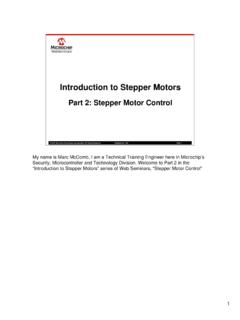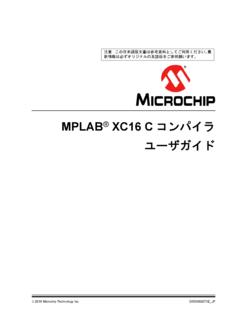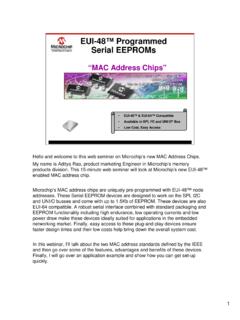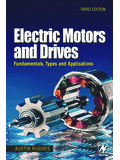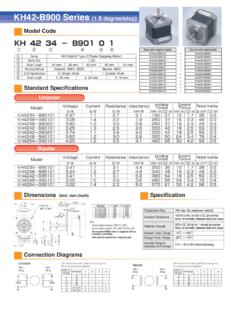Transcription of Introduction to Stepper Motors - Microchip …
1 1 2007 Microchip technology Incorporated. All Rights Reserved. Introduction to Stepper Motors Slide 1 Introduction to Stepper MotorsPart 1: Types of Stepper MotorsHello, my name is Marc McComb, I am a Technical Training Engineer here at Microchip technology in the Security, Microcontroller and technology Division. Thank you for downloading Introduction to Stepper Motors . This is Part 1 in a series of webseminars related to Stepper motor Fundamentals. The following webseminar will focus on some of the Stepper Motors available for your applications. So let s 2007 Microchip technology Incorporated. All Rights Reserved. Introduction to Stepper Motors Slide 2 AgendazTopics discussed in this WebSeminar: Main components of a Stepper motor How do these components work together Types of Stepper motorsDuring this webseminar I will discuss the main components of a Stepper motor and how these components work together to actually turn the rotor.
2 We will also explore three types of stepping Motors as well as two sub 2007 Microchip technology Incorporated. All Rights Reserved. Introduction to Stepper Motors Slide 3 Stepper motor BasicsSo let s start off with some Stepper motor basics4 2007 Microchip technology Incorporated. All Rights Reserved. Introduction to Stepper Motors Slide 4 What is a Stepper motor ?zMotor that moves one stepat a time A digital version of an electric motor Each step is defined by a Step AngleStart PositionStep 1 Step 2 First, what is a Stepper motor ? As the name implies, the Stepper motor moves in distinct steps during its rotation. Each of these steps is defined by a Step Angle.
3 In the example above you may notice that there are 4 distinct steps for the rotor to make a complete 360 degree rotation. This defines the step angle at 90 degrees. Since this motor does move in a discreet fashion, we can say that a Stepper motor is actually a digital motor . This characteristic makes it very suitable for digital interfaces such as with a 2007 Microchip technology Incorporated. All Rights Reserved. Introduction to Stepper Motors Slide 5 Why a Stepper motor ?zRelatively inexpensivezIdeal for open loop positioning control Can be implemented without feedback Minimizes sensing devices Just count the steps!zTorque Holds its position firmly when not turning Eliminates mechanical brakes Produces better torque than DC Motors at lower speedszPositioning we have this motor that moves in distinct and why would I use it?
4 Stepper Motors are relatively inexpensive as compared to other motor types. Let me emphasize the word relatively. There are a number of Stepper motor designs that run from the most basic to very on the motor you choose, the resolution required and the application at hand will determine the cost of the motor required. More important is the fact that a Stepper motor can actually be used without any type of feedback loop. Since the motor moves in distinct steps as defined by a step angle, we need only count the number of steps to position the motor accordingly. This doesn t mean you wouldn t use a feedback loop in some applications. However, if feedback isn t required, board real estate can be maximized by minimizing these sensing unique torque characteristics of the Stepper motor make it ideal for position applications.
5 In fact, Stepper Motors have been used for years in such applications as printers and machining equipment. This type of motor will hold its position firmly at a given step providing a relatively high holding torque. Other torque related benefits include the higher torque at lower revolutions per minute than your typical DC motor as well as no need for mechanical 2007 Microchip technology Incorporated. All Rights Reserved. Introduction to Stepper Motors Slide 6 Main ComponentszConsists of Stators Holds multiple windings/phasesStatorsWindings/phasesA Stepper motor has some basic components. First, we have a soft iron stator. As the name implies this is a stationary component.
6 Each stator will be wrapped with multiple windings or phases that will be energized using a voltage source, initiating current flow through the winding to produce a polarity on each end or pole of the 2007 Microchip technology Incorporated. All Rights Reserved. Introduction to Stepper Motors Slide 7 Main ComponentsNSzConsists of Stators Holds multiple windings/phases A Rotor Magnetized Non-magnetizedThe rotor is the actual rotating component on the motor . This can either be magnetized, as shown here, or non-magnetized depending on the type of motor you select. We will discuss some of these different motor types later in the 2007 Microchip technology Incorporated.
7 All Rights Reserved. Introduction to Stepper Motors Slide 8 Main ComponentszVoltage applied to winding initiates current flowzMagnetic flux begins to flowNSSSNNV+WindingCurrentMagneticFluxIn this example, if we apply a voltage across the windings around a stator, current will flow through the winding. If you remember back in school, your professor may have discussed the right hand rule. If you take your right hand and position your fingers over a winding in the direction of current flow, you thumb will point in the direction of the magnetic flux. Here we can see that each end of the stator is magnetized to opposite poles. Magnetic flux will flow from North to South thereby continuing through the magnetic rotor to the opposite stator pole.
8 The flux will want to travel the path of least resistance or decrease the reluctance of the 2007 Microchip technology Incorporated. All Rights Reserved. Introduction to Stepper Motors Slide 9 Main ComponentsSSNNV+NSzVoltage applied to winding initiates current flowzMagnetic flux begins to flowzRotor rotates to minimize flux path (or reluctance)Since the rotor does rotate it will position itself to minimize this reluctance. As you can see, by adding more stators and phases, we can charge a winding attracting the rotor poles accordingly then remove the applied voltage allowing other stators to attract the rotor 2007 Microchip technology Incorporated. All Rights Reserved.
9 Introduction to Stepper Motors Slide 10 Types of Stepping MotorsAs I mentioned there are a number of different types of Stepper 2007 Microchip technology Incorporated. All Rights Reserved. Introduction to Stepper Motors Slide 11 Types of Stepper MotorszPermanent Magnet Magnetic rotorzVariable Reluctance Non-magnetic, geared rotorzHybrid Combines characteristics from PM and VR Magnetic, geared rotorThe first type, we have already seen in this web seminar the Permanent Magnet Stepper motor . This is the motor that has the magnetized variable reluctance type motor replaces the magnetic rotor with a geared, non-magnetized, soft-iron , the hybrid type of motor combines characteristic from both the Permanent Magnet and Variable Reluctance Motors .
10 As you will see, this type of motor offers very high rotational resolutions as well as improved 2007 Microchip technology Incorporated. All Rights Reserved. Introduction to Stepper Motors Slide 12 Permanent Magnet MotorzMagnetic RotorNNSSROTORROTORAA BB AA BB The permanent magnet type of Stepper motor has the characteristic magnetized rotor. During the rest of this webseminar we will use the nomenclature shown on the above slide. Each winding, although one entity, will be subdivided. Above I ve labeled Winding A, for example, as A and A and Winding B as B and B . Keep this in mind as we continue through this web 2007 Microchip technology Incorporated. All Rights Reserved.
